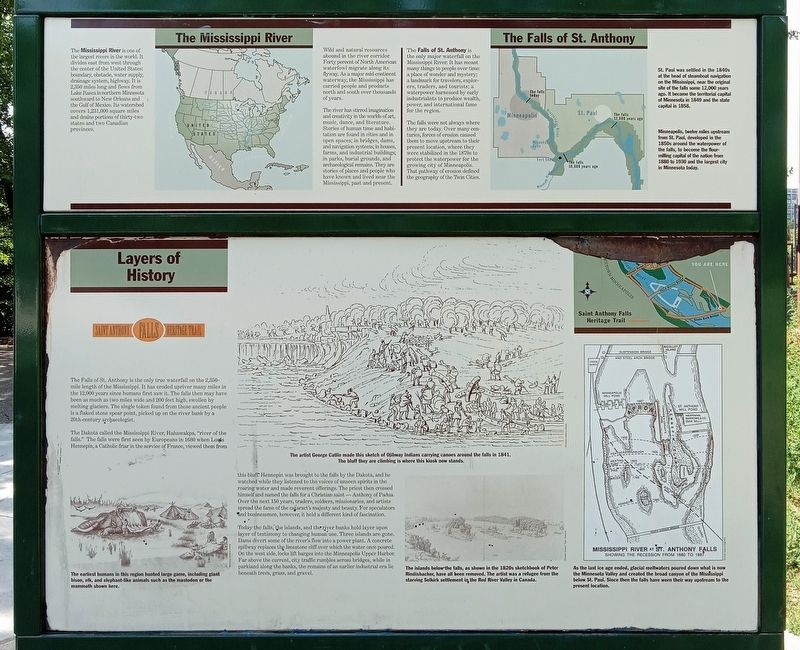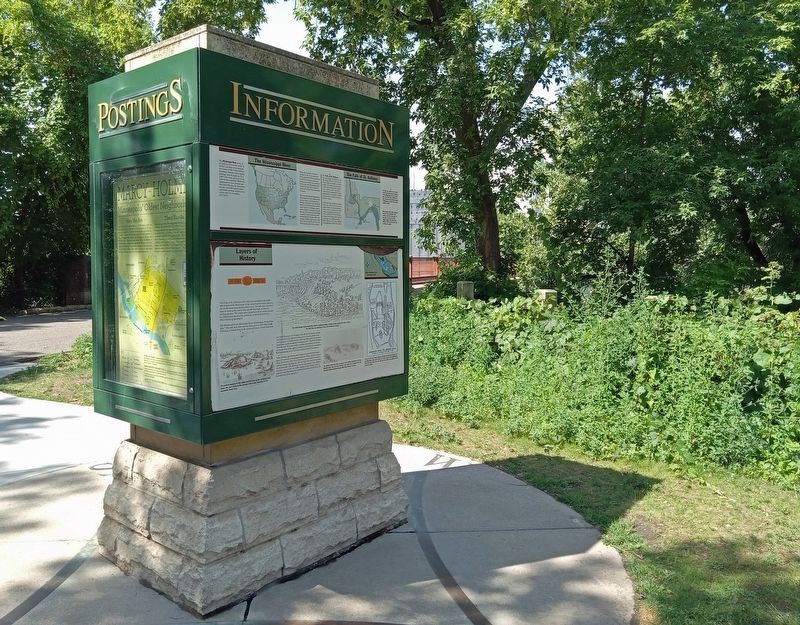Saint Anthony Main in Minneapolis in Hennepin County, Minnesota — The American Midwest (Upper Plains)
Layers of History
— Saint Anthony Falls Heritage Trail —
The Falls of St. Anthony is the only true waterfall on the 2,350-mile length of the Mississippi. It has eroded upriver many miles in the 12,000 years since humans first saw it. The falls then may have been as much as two miles wide and 200 feet high, swollen by melting glaciers. The single token found from those ancient people is a flaked stone spear point, picked up on the river bank by a 20th-century archaeologist.
The Dakota called the Mississippi River, Hahawakpa, "river of the falls." The falls were first seen by Europeans in 1680 when Louis Hennepin, a Catholic friar in the service of France, viewed them from this bluff. Hennepin was brought to the falls by the Dakota, and he watched while they listened to the voices of unseen spirits in the roaring water and made reverent offerings. The priest then crossed himself and named the falls for a Christian saint — Anthony of Padua. Over the next 150 years, traders, soldiers, missionaries, and artists spread the fame of the cataract's majesty and beauty. For speculators and businessmen, however, it held a different kind of fascination.
Today the falls, the islands, and the river banks hold layer upon layer of testimony to changing human use. Three islands are gone. Dams divert some of the river's flow into a power plant. A concrete spillway replaces the limestone cliff over which the water once poured. On the west side, locks lift barges into the Minneapolis Upper Harbor. Far above the current, city traffic rumbles across bridges, while in parkland along the banks, the remains of an earlier industrial era lie beneath trees, grass, and gravel.
The earliest humans in this region hunted large game, including giant bison, elk, and elephant-like animals such as the mastodon or the mammoth shown here.
The artist George Catlin made this sketch of Ojibway Indians carrying canoes around the falls in 1841. The bluff they are climbing is where this kiosk now stands.
The islands below the falls, as shown in the 1820s sketchbook of Peter Rindisbacher, have all been removed. The artist was a refugee from the starving Selkirk settlement in the Red River Valley in Canada.
As the last ice age ended, glacial meltwaters poured down what is now the Minnesota Valley and created the broad canyon of the Mississippi below St. Paul. Since then the falls have work their way upstream to the present location.
The Mississippi River
The Mississippi River is one of the largest rivers in the world. It divides east from west through the center of the United States: boundary, obstacle, water supply, drainage system, highway. It is 2,350 miles long and
flows from Lake Itasca in northern Minnesota southward to New Orleans and the Gulf of Mexico. Its watershed covers 1,231,000 square miles and drains portions of thirty-two states and two Canadian provinces.
Wild and natural resources abound in the river corridor. Forty percent of North American waterfowl migrate along its flyway. As a major mid-continent waterway, the Mississippi has carried people and products north and south over thousands of years.
The river has stirred imagination and creativity in the worlds of art, music, dance, and literature. Stories of human time and habitation are found in cities and in open spaces; in bridges, dams, and navigation systems; in houses, farms, and industrial buildings; in parks, burial grounds, and archaeological remains. They are stories of places and people who have known and lived near the Mississippi, past and present.
The Falls of St. Anthony
The Falls of St. Anthony is the only major waterfall on the Mississippi River. It has meant many things to people over time: a place of wonder and mystery; a landmark for travelers, explorers, traders, and tourists; a waterpower harnessed by early industrialists to produce wealth, power, and international fame for the region.
The falls were not always where they are today. Over many centuries, forces of erosion caused them to move upstream to their present location, where they were stabilized in the 1870s to protect the waterpower for the growing city of Minneapolis. That pathway of erosion defined the geography of the Twin Cities.
St. Paul was settled in the 1840s, at the head of steamboat navigation on the Mississippi, near the original site of the falls some 12,000 years ago. It became the territorial capital of Minnesota in 1849 and the state capital in 1858.
Minneapolis, twelve miles upstream from St. Paul, developed in the 1850s around the waterpower of the falls, to become the flour-milling capital of the nation from 1880 to 1930 and the largest city in Minnesota today.
Erected by St. Anthony Falls Heritage Board.
Topics. This historical marker is listed in these topic lists: Anthropology & Archaeology • Industry & Commerce • Native Americans • Waterways & Vessels.
Location. 44° 58.878′ N, 93° 15.045′ W. Marker is in Minneapolis, Minnesota, in Hennepin County. It is in Saint Anthony Main. Marker can be reached from 6th Avenue Southeast south of Southeast Main Street. The marker is in Father Hennepin Park, on an information kiosk at the east end of the Stone Arch Bridge. Touch for map. Marker is at or near this postal address: 830 Southeast Main Street, Minneapolis MN 55414, United States of America. Touch for directions.
Other nearby markers. At least 8 other markers are within walking distance of this marker. Marcy~Holmes (here, next to this marker); The Stone Arch Bridge (a few steps from this marker); Father Hennepin Bluffs (a few steps from this marker); Portaging Around the Falls (within shouting distance of this marker); Lucy Wilder Morris (within shouting distance of this marker); Pettingill's Wonderful Water (about 300 feet away, measured in a direct line); Sawmilling: The City's First Industry (about 400 feet away); The Pillsbury A Mill (about 700 feet away). Touch for a list and map of all markers in Minneapolis.
Credits. This page was last revised on March 25, 2024. It was originally submitted on December 23, 2023, by McGhiever of Minneapolis, Minnesota. This page has been viewed 48 times since then and 18 times this year. Photos: 1, 2. submitted on December 23, 2023, by McGhiever of Minneapolis, Minnesota. • Devry Becker Jones was the editor who published this page.

